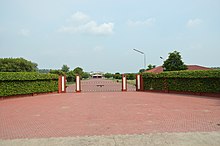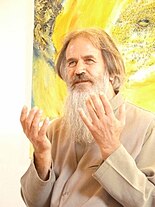Radha Soami


Radhasoami Satsang, is a religious organization founded by Most Revered Param Purush Puran Dhani Shri Shiv Dayal Singh Sahab in 1861 on Basant Panchami Day in Agra, India.[1][2][3]
The Name Radhasoami is accentuated as the reverbation and emanation of the Supreme Being.
The Radhasoami Mat followers, states Mark Juergensmeyer, are considered in Punjab as an offshoot of Sikhism[4] and can also be considered a part of Hinduism because they share their cultural outlook, some practices and theological concepts such as karma, yoga (shabd) and guru. However, they are also different from Hindus and Sikhs because they reject the concept of a sacred scripture, rituals such as Karah Parshad and pilgrimage gatherings and ceremonies. The Radhasoami mat followers are a religious fellowship that accepts saints and living gurus from anywhere.[4]
The movement started in Agra, its contemporaneous headquarters are in Beas, with parallel branches found in India and outside India.[1][4][5] There are over 30 different Radhasoami groups in the world.[5] elsewhere such as in Dayalbagh, Agra.
According to Pierluigi Zoccatelli, there were an estimated 3 million Radhasoami followers worldwide in 2004, with many subsects based on the Guru. Of these, the Radha Soami Satsang Beas is the largest[5] and it had 2 million followers.[6] Other subsects and movements influenced by Radhasoami include Divine Light Mission, Eckankar, Movement of Spiritual Inner Awareness, Science of Spirituality and others.[6] Some of these groups have tried to distance themselves from the other.[5] [5]
Nomenclature
According to Mark Juergensmeyer, the term Radhasoami literally refers to Radha as consort and Soami as lord (swami, lord).[7] But these terms do not mean the human manifestations, rather they refer to the Vaishnava understanding of "Radha as the power of energy of God (Shakti), and "swami of Radha" as "master of energy". It is a referent to the consciousness in a person and the cosmic energy source, states Juergensmeyer.[7]
The writings of Param Purush Puran Dhani Huzur Swami Dayal use the term Sat Nam, as well as Radhasoami. The gurus and the tradition that followed him used the term Radhasoami during the initiation rites, meditation practices and as mutual greeting. This has led to the fellowship being commonly called Radha Soami.[7] In some subtraditions of Radhasoami, states Lucy DuPertuis, the guru's charisma is considered as the "formless absolute", being in his presence is equivalent to experiencing the incarnation of the Satguru, the guru is identified as the Supreme Being Himself.[8]
Beliefs and practices
To the Radhsoamis, six elements form the framework of their faith:[9]
- a living guru (someone as locus of trust and truth),
- bhajan (remembering Sat Nam, other practices believed to be transformative),
- satsang (fellowship, community),
- seva (serve others without expecting anything in return),
- kendra (community organization, shrine), and
- bhandara (large community gathering).
The Radha Soami Satsang believes that living gurus are necessary for a guided spiritual life.[1] They do not install the Guru Granth Sahib or any other scriptures in their sanctum, as they consider it ritualistic. Instead, the guru sits in the sanctum with the satsang (group of Sikh faithfuls) and they listen to preachings from the Adi Granth and sing hymns together.[1] They believe in social equality, forbid caste distinctions. They are active outside India, and attracted converts to their movement.[1]
The Radhasoami are strict vegetarians. They are active in charitable work such as providing free medical services and help to the needy. They do believe in some orthodox Sikh ritual practices such as covering one's head inside the temple or removing shoes, and they serve anandabazar (offering) at the end of prayers.[1] Their basic practices include Surat Shabd Yoga (sound assisted meditation), initiation of disciple into the path by a living guru, obedience to the guru, a moral life that is defined by abstinence from meat, drugs, alcohol. They also believe that jivanmukti or inner liberation is possible during one's lifetime with guidance of the living guru.[5]
See also
- Gurus
- Jaimal Singh
- Sawan Singh
- Hazur Rai Saligram Bahadur
- Gurinder Singh
- Bhagat Munshi Ram
- Kirpal Singh
- Paul Twitchell
References
- ^ a b c d e f g Kristen Haar; Sewa Singh Kalsi (2009). Sikhism. Infobase Publishing. pp. 12–13. ISBN 978-1-4381-0647-2.
- ^ Mark Juergensmeyer (1995). Radhasoami Reality: The Logic of a Modern Faith. Princeton University Press. p. 90 note 5. ISBN 0-691-01092-7., Quote: "The date of Swami Shiv Dayal's first public discourse is Basant Panchami Day, February 15 1861"
- ^ David N. Lorenzen (1995). Bhakti Religion in North India: Community Identity and Political Action. State University of New York Press. p. 67. ISBN 978-0-7914-2025-6., Quote: "The movement traces its origins to Swami Shiv Dayal Singh, who began his public ministry in Agra in 1861."
- ^ a b c Mark Juergensmeyer (1995). Radhasoami Reality: The Logic of a Modern Faith. Princeton University Press. pp. 7–8, 14–18, 23, 55–57. ISBN 0-691-01092-7.
- ^ a b c d e f James R. Lewis (2002). The Encyclopedia of Cults, Sects, and New Religions. Prometheus. pp. 590–592. ISBN 978-1-61592-738-8.
- ^ a b Pierluigi Zoccatelli (2004). Peter Clarke (ed.). Encyclopedia of New Religious Movements. Routledge. pp. 508–509. ISBN 978-1-134-49970-0.
- ^ a b c Mark Juergensmeyer (1995). Radhasoami Reality: The Logic of a Modern Faith. Princeton University Press. pp. 41–42 with footnotes. ISBN 0-691-01092-7., Quote: "The word Radhasoami literally refers to Krishna as lord (swami) of his consort, Radha" (p. 41); "The Beas group translates Radhasoami as 'lord of the soul' (p. 42).
- ^ DuPertuis, Lucy (1986). "How People Recognize Charisma: The Case of Darshan in Radhasoami and Divine Light Mission". Sociological Analysis. 47 (2). Oxford University Press: 111–124. doi:10.2307/3711456., Quote: "Various branches of Radhasoami have argued about the incarnationalism of Satguru (Lane, 1981). Guru Maharaj Ji has accepted it and identifies with Krishna and other incarnations of Vishnu."
- ^ Mark Juergensmeyer (1995). Radhasoami Reality: The Logic of a Modern Faith. Princeton University Press. pp. 11–12, 40–42. ISBN 0-691-01092-7.
- ^ Larson, Gerald J. India's Agony Over Religion (1995). p. 136. SUNY Press (State University of New York) ISBN 0-7914-2411-1
Further reading
- Juergensmeyer, Mark (1991). Radhasoami Reality: The Logic of a Modern Faith, Princeton, New Jersey: Princeton University Press. ISBN 0-691-07378-3
- Lane, David C (1992). The Radhasoami Tradition, New York. Garland Publishing. ISBN 978-0-8240-5247-8
- Schomer, Karine & William Hewat McLeod, eds (1987).The Sants: Studies in a Devotional Tradition of India, Delhi: Motilal Banarsidass, 1987. Academic papers from a 1978 Berkeley conference on the Sants organised by the Graduate Theological Union and the University of California Center for South Asia Studies. ISBN 81-208-0277-2



